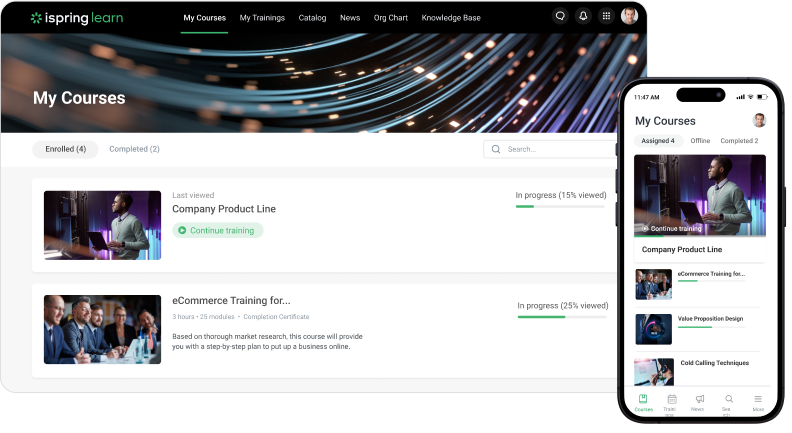5 Podia Alternatives: A Features Comparison

If you’re looking for the right platform to create and sell online courses, then you’ve likely come across a dizzying amount of options. Fortunately, you can narrow them down by determining your course and business needs. For example:
- Are you hoping for a relatively hands-off solution or one that allows for deep customization?
- Do you need to create a professional website with product pages, third-party integrations, and a complete sales funnel?
- Are you going to build simple or engaging interactive courses?
If you’ve stumbled upon a Podia review in your search for an ideal eLearning platform and are feeling ready to take the leap, then make sure you’ve done your due diligence and read ahead. In this article, we’re going to present five comparable Podia alternatives. But before we introduce them, let’s have a look at Podia to see what it offers.
Podia Review
Platform overview
Podia is an all-in-one online course platform that lets you house and sell an unlimited number of courses, digital downloads, and memberships. Its creator-first mentality enables businesses and training centers to simply focus on content proliferation rather than the logistics of building a website and getting their courses to market.
The design of the backend is highly intuitive and simplistic, eliminating the need for specialized technical know-how, coding, or programming. All you have to do is upload your digital content. Podia supports the following media types:
- Videos (MOV, MP4, and MP3)
- Images (PNG, JPG, GIF, and PDF)
- EPUB and MOBI
- .sketch, AI and PSD
That being said, if you’re using authoring tools that can publish courses using SCORM , Tin Can, or AICC, Podia won’t be of any use to you. It’s best for those who’re creating simple, standalone courses that are packaged as digital products or downloads.
Podia’s easy-to-use website builder functions as your entire sales funnel. You simply need to choose from a selection of pre-built themes and take it from there. Potential customers can easily access your storefront, browse your professional-looking sales pages, and make payments. However, remember that you’re quite limited in terms of controlling the look and feel of your website and incorporating branding.
Nevertheless, Podia offers a host of marketing options to make it a worthy competitor in the market, including email and affiliate marketing, an integrated membership site that can be bundled with other products, and a host of integrations, including Facebook, Google Ads, and GetResponse, among others.
Pros
- Intuitive and easy to use
- Unlimited hosting, storage, and bandwidth
- No transaction fees
- Instant payout
- Third-party integrations
Cons
- Doesn’t support SCORM, Tin Can, or AICC content types
- Can only create simple, one-tiered courses
- Can’t create learning paths
- No built-in quizzes
- No course completion certificates
Pricing
Podia has two very affordable plans.
- Mover plan. $39/month. In this plan, you get everything you need to launch and sell your courses, including a storefront, unlimited courses and digital downloads, and email marketing.
- Shaker plan. $79/month. This plan includes everything in the Mover plan, but unlocks extra e-commerce features such as memberships, blog pages, affiliate marketing, and embedded checkouts.
Final verdict
Podia connects your website, products, email marketing campaigns, and sales, thus enabling you to create your entire sales funnel in one place. It is a good fit for entrepreneurs or individual creators who want to sell digital products and run their business without having to learn and manage multiple online course platforms. That being said, from an instructional design standpoint, Podia courses are quite limited. If you’d like to create structured, hierarchical courses with learning paths or higher levels of engagement, such as dialog simulations or interactive graphics, then you’ll need to look elsewhere.
Podia Alternative #1 – iSpring Learn

Platform overview
iSpring Learn is a highly comparable alternative to Podia. It’s user-friendly, entirely intuitive, and helps you get your course marketplace up and running quickly and easily.
iSpring Learn supports virtually every file type:
- Videos (MP4, FLV)
- Documents (PDF, DOC, XLS)
- Presentations (PPT)
- SCORM packages (quizzes, simulations, etc.)
Building and managing online courses with iSpring Learn is extremely easy. You can create courses right in the LMS with interactive exercises and assessments. This means you can develop engaging content without needing to juggle multiple platforms.
But that’s not all — iSpring Learn is also integrated with iSpring Suite, a robust authoring tool that takes your course creation to the next level. With iSpring Suite, you can craft professional-grade courses, quizzes, role-plays, and training videos. Once your content is ready, you can simply publish it to the platform.
Another great option with iSpring Learn is that it enables you to design certification programs and issue certificates automatically. All of these instructional design features give it a distinct edge over Podia.
iSpring Learn is integrated with Shopify, which allows you to sync courses with your Shopify storefront and let customers purchase your courses directly from your online store.
This integration gives course creators all the tools they need to sell courses effortlessly. You can easily add course details, set prices, and offer secure payment options for learners everywhere. Shopify also handles the behind-the-scenes stuff like invoicing and taxes, so you can concentrate on creating your eLearning content.
iSpring Learn’s got you covered on both the instructional design and e-commerce sides of creating, hosting, and selling online courses. Moreover, it provides thorough analytics, providing deep insights into both learner progress and activity, as well as comprehensive sales and revenue data.
Pros
- Intuitive learning portal
- Creates learning paths/structured courses
- Two content authoring tools
- Creates certificate programs/certificates
- Balances e-commerce and course design features nicely
- Automates administrative tasks
- Robust analytics and reporting
Cons
- Dependence on integration with Shopify
- Limited e-commerce features
Pricing
iSpring Learn offers two subscription tiers: Start and Business. The Start plan includes basic LMS features, while the Business plan adds exclusive capabilities like integration with Shopify. Both plans use an active-user pricing strategy, charging only for users who log in at least once during a specific month. Pricing for the Business plan is the following:
- 300 users: $4.10 USD per user/month
- 500 users: $3.75 USD per user/month
- Less or more users: upon request
Book a free demo of iSpring Learn and get insights from our eLearning experts on how to launch your eCommerce project!
Final verdict
iSpring Learn is an ideal platform for businesses and training centers that wish to create highly-structured courses or complete certification programs quickly and easily. Moreover, it supports almost every file type, which opens the door to a wide host of online course designs and high levels of interactivity. If you’re looking for a platform that’ll enable you to effortlessly generate organic traffic from major search engines and bolster sales, then iSpring Learn has you covered.
Podia Alternative #2 – Kajabi
Platform overview
Kajabi is an online course platform that borrows elements from both Podia and iSpring Learn. Like Podia, it doesn’t enable the creation of hierarchical course structures – all of your courses are actually termed “digital products”. And rather than referring to itself as an eLearning platform or learning management system, Kajabi positions itself more as an “online business platform”. So, you’re quite limited in terms of course creation features, but its marketing and sales features are elaborate and intricate, possibly to the point of needing formal training or specialized knowledge.

Kajabi includes a course editor, allowing you to build content right out of the platform, but many users have mentioned its lack of intuitiveness. Still, you can create courses that include different types of multimedia, such as presentations, digital documents, and audio files. If you wish to incorporate videos, one downfall is that you’ll need to utilize third-party websites like YouTube or Wistia to host them.
However, as mentioned, Kajabi’s main strength lies in its marketing options. Not only does it allow you to create highly-customized websites, but it contains a host of built-in themes for landing pages, allows you to build an intricate sales pipeline, and launches a variety of marketing campaigns. However, these valuable tools come at a cost – Kajabi’s definitely one of the pricier options on this list. So if you already have a customized website with marketing tools in place, or you’re not at least moderately savvy with digital marketing techniques, you won’t get the most out of this software.
Pros
- Wide variety of marketing options
- Highly customizable websites
- Can build your own sales pipeline
- Hosts webinars
Cons
- Platform not specifically geared towards eLearning (i.e., geared to online businesses in general
- Courses lack structure/learning paths
- Interface might require a learning curve
- Requires knowledge of digital marketing techniques
- Price
Pricing
Effective marketing tools come at a cost, and Kajabi is priced accordingly. Kajabi’s pricing structure entails three plans:
- Basic. $119/month.
- Growth. $159/month.
- Pro. $319/month.
In the Basic plan, you have everything you need to launch and effectively market and sell courses. For example, you can host your products, create landing pages and custom websites, and build your own sales pipeline. However, as you go up in plans, you get access to more advanced features, such as affiliate marketing, advanced automation, and white-labeling. In addition, you get more of certain features. For example, instead of three products and pipelines in the Basic plan, the Growth plan offers 15 while the Pro plan offers 100.
Final verdict
If you don’t mind getting your hands dirty in the online course marketing process, then Kajabi’s a great option. While your courses will be standalone and one-tiered in nature, you’ll have all the necessary marketing tools under one roof to ensure that your online course offerings reach your intended market. Moreover, if you’d like control over the look and feel of your storefront and sales funnel, then Kajabi’s right for you. But if you’d like more control over the design and structure of your courses, then you might find Kajabi limiting.
Podia Alternative #3 – Thinkific
Platform overview
Thinkific is one of the biggest names in the eLearning platform game. It allows you to create, market, and sell your online courses while remaining true to your brand identity.
For example, Thinkific contains a Site Builder tool that gives you three themes to choose from, each of which allows for branding customization like adding your own color scheme, font styles, and a variety of multimedia, such as images, videos, and audio files.

With Thinkific, you can create well-structured courses that are organized into “Chapters” (or “modules”). In addition to the ability to incorporate videos, audio files, presentations, and images into your courses, it has a built-in quiz and survey builder. However, as with Kajabi, if you need to host your videos, you’ll have to use a third-party service like Wistia. You can also embed them via YouTube, Vimeo, or third-party platforms like Brillium Exams.
As for e-commerce key features, Thinkific offers all the necessities. In addition to incentivization methods, such as coupons, freebies, and discounts, it is also compatible with a range of third-party integrations, such as the ActiveCampaign and ConvertKit email marketing tools.
Despite its customization options, and the fact that it nicely balances its online course design and e-commerce feature sets, Thinkific is an intuitive platform with a minimal learning curve for even the most technologically-challenged.
Pros
- Highly intuitive platform
- Moderate level of customization options
- Includes learner-focused course design features
- Variety of third-party integrations
- Allows you to bulk import different file types
Cons
- Videos must be hosted through Wistia
- No support for SCORM/Tin Can/AICC content
Pricing
Thinkific has four relatively affordable pricing plans, as follows:
- Free plan. $0. You can do everything you need with this plan, such as hosting courses, creating quizzes, and having an unlimited number of students. However, you can only host/sell three courses before upgrading.
- Basic plan. $49. This plan includes everything in the Free plan, plus it allows you to host/sell an unlimited number of courses, and tacks on additional administrative and advanced marketing features.
- Pro plan. $99. This is Thinkific’s most popular plan. It entails everything in the Basic plan but adds extra admin features, such as two site admins and five course authors. This plan also allows you to create memberships and includes advanced customizations.
- Premier plan. $499. The Premier plan naturally encompasses everything in the Pro plan, but this is for the “big fish” within the eLearning biz. It allows for five site admins and 50 course authors. In addition, you also get an onboarding package as this plan assumes major business growth.
Final verdict
Thinkific is a solid option if you’re an edupreneur or business who’s looking for a low-tech way to quickly design, build, and sell online courses. While its Site Builder tool only offers three themes, you still have a moderate number of customization options for your websites, such as the color scheme, font styles, as well as white-labeling. Moreover, with its lack of SCORM/Tin Can/AICC support, you won’t be able to sell online courses with interactive quizzes or branching scenarios. Though courses will be able to include a wide variety of multimedia, they will enable passive learning.
Podia Alternative #4 – Teachable
Platform overview
Teachable is another alternative to Podia and a highly comparable platform to Thinkific. As a matter of fact, within the eLearning realm, the latter two often face-off against one another directly. But there are quite a few distinguishable key features among them. For example, while Teachable is just as user-friendly and easy to navigate as Thinkific, Teachable still offers additional branding and customization options that are lacking in Thinkific. Nevertheless, Teachable is markedly more affordable than Thinkific.

The online course creation process in Teachable is simple. It accepts your standard range of content, including movies, images, mp3 audio files, and PDFs – all you have to do is upload them. However, as with Thinkific, Teachable doesn’t support SCORM, meaning that while your courses can contain a variety of multimedia, they will mainly involve passive versus active (or interactive) learning.
Still, Teachable has key online course creation features. For example, you can easily organize your courses into “sections” and “lectures” (modules and lessons, respectively), and create quizzes, however limited in question type (i.e., multiple-choice only).
Teachable also has a host of highly-effective e-commerce options. For example, you can sell your online courses on a fixed-price, subscription, or membership basis. And of course, you have different options to spur potential buyers to action, such as discounts and add-ons. However, while Thinkific’s Site Builder offers three distinct themes, Teachable only offers one. The plus side is that Teachable does allow for HTML/CSS coding on each site – a fine way to counterbalance the lack of theme options.
Pros
- Highly-intuitive, user-friendly interface
- HTML/CSS coding enabled on all webpages
- Can create structured courses
- High-converting sales funnel
Cons
- Only offers one theme for webpages
- No support for SCORM/high-interactivity courses
- Limited quiz-building options (multiple-choice only)
- Affordable pricing plans
Pricing
As mentioned, Teachable is noticeably cheaper than Thinkific. Its pricing structure is arranged into three plans – Basic, Professional, and Business (all billed annually):
- Basic. $29/month.
- Professional. $79/month.
- Business. $399/month.
While all the plans enable an unlimited amount of online course uploads, users, storage, and bandwidth, unlike the upgraded plans, the Basic plan charges a 5% transaction fee. The Professional plan includes everything in Basic, with additional online course design and advanced marketing features, such as graded quizzes, certificates, and advanced website customization. And naturally, the Business plan includes everything in the Professional plan, but tacks on additional admin features, such as 100 admin users and bulk enrollment.
Final verdict
Teachable is a solid platform for businesses and training centers who’re looking for a low-tech, affordable solution to create, house, and sell online courses all in one place. It’s a great option if you’d like a slightly customizable solution that’s simultaneously hands-off. However, because it doesn’t support SCORM, the courses hosted on Teachable can be comparatively low on the interactivity scale. Still, you can still sell multimedia-rich and structured courses on this platform.
Podia Alternative #5 – Gumroad

Platform overview
Gumroad is another alternative to Podia that’s been in the e-commerce industry since 2011. However, it’s not as big a name in the eLearning world because the platform isn’t specific to selling online courses so much as it is “digital products”. For example, you can just as easily use it to market and sell music, eBooks, and even physical products. Unfortunately, that means if you’re looking to sell highly-structured, full-fledged eLearning programs with Gumroad, you’re out of luck.
Gumroad functions more as a repository of digital downloads. So, all your courses will need to be self-contained within one digital product, which — of course — minimizes the degree of design elements you can include in your courses. As a result, you cannot incorporate any interactivity in your courses. However, if that’s the course design model you’re following, then Gumroad might be right for you.
Regarding Gumroad’s e-commerce key features, you have the option to sell your products according to three business models – fixed-price, subscription, and preorder (for users who’re anticipating a new launch). The platform completely takes care of your storefront while still allowing you to personalize your landing page with your own color scheme, custom URLs, or CSS coding.
However, for a platform that primarily functions as a shopping cart, Gumroad is quite limited in terms of incentivizes. For example, for buyer incentives, it only allows for coupon codes rather than upsells, bundles, or even order bumps.
All in all, Gumroad is not a bad place to start if you’re a beginner who has pre-designed, self-contained content that you’re looking to sell with minimal involvement.
Pros
- Good for beginners; simple to use
- Allows for CSS customization
- Highly affordable
- Third-party integrations (ConvertKit, Infusionsoft, Drip)
Cons
- Can only create/sell very basic courses (low interactivity)
- Minimal to no course design features
- Basic e-commerce features
- Platform not specific to eLearning realm
Pricing
Gumroad has two simple pricing plans:
- Free. In the free account, you can create and customize your storefront and sell as many digital products as you like, but you will have limitations on e-mail dispatching. The only time you pay is when you make a sale. Gumroad takes 8.5% + $0.30 (USD) per sale.
- Premium. $10/month. With the Premium plan, you get everything in the Free plan alongside advanced features such as 3rd-party analytics, CSS customization, and custom domains. In this plan, the transaction fees per sale drop to 3.5% + $0.30 (USD) per sale.
Final verdict
Bear in mind that — first and foremost — Gumroad is a shopping cart, but with very basic features. While it’s not the best for businesses that need all the bells and whistles, if you’re looking to get up and running quickly, it’s a highly affordable option for beginners. Moreover, if you’re creating eLearning products rather than full-fledged courses that follow a curriculum or structure, then this platform is highly limiting.
Podia Alternatives: Final Thoughts
Choosing the right eLearning platform can be a daunting and multifactorial process. But as long as you have a clear idea about your business and eLearning goals, you should be able to easily narrow down the options.
If you’re hoping to create and sell highly interactive, engaging eLearning courses that are well-structured with learning paths and offer completion certificates, then iSpring Learn is a solid alternative to Podia. It’s also the only platform that supports SCORM content.
However, if you’re creating simple, self-contained/standalone courses, then Podia, Kajabi, and Gumroad are your best bets. While Podia is simple to use and offers everything you need, its marketing options are nowhere near Kajabi’s. That being said, Podia still offers more in the way of e-commerce than Gumroad, which takes simplicity to a whole new level and merely functions as a basic shopping cart.
Teachable and Thinkific are also solid options. They provide everything you need to sell engaging courses, but unfortunately, neither are SCORM compliant.
Simply ask yourself what kind of courses you’re creating, how quickly you’d like to launch and sell them, and how involved you’d like to be with marketing, sales, and customization.
But to get started, book a demo of iSpring Learn for free! Our managers will be happy to show you how to run your training business with ease.








